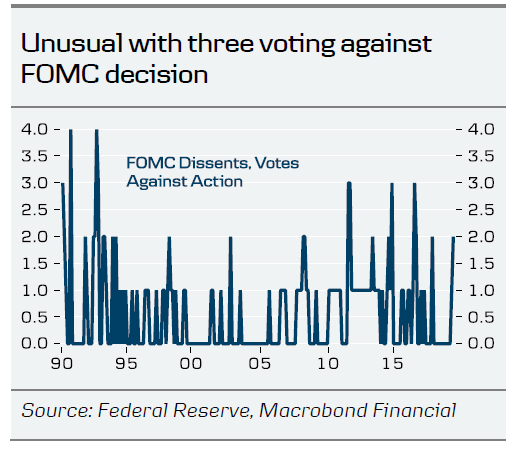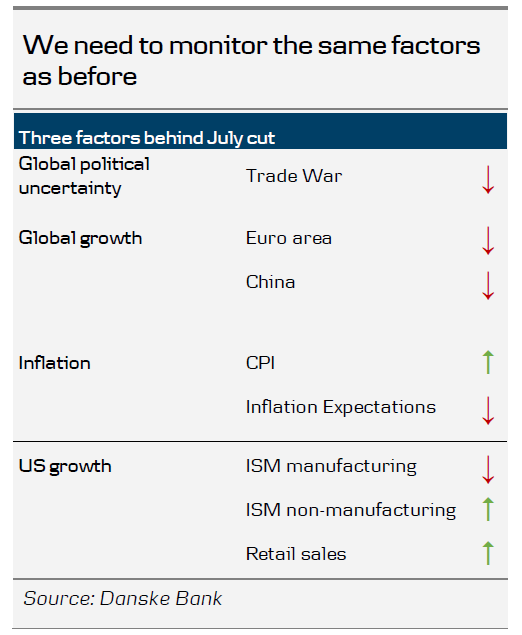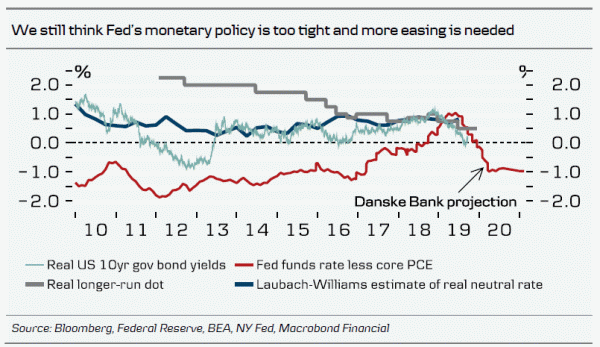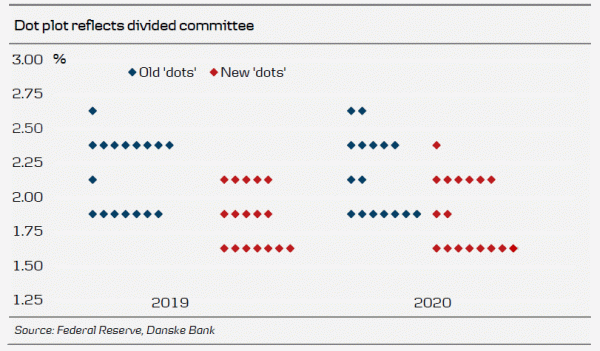Still no pre-commitment to more easing
As expected, the Federal Reserve cut its target range by 25bp to 1.75-2.00%. Not very surprisingly we had three dissenters with Rosengren and Esther calling for no cut (as they did in July) and Bullard calling for a more aggressive cut of 50bp. We have a clear division in the committee and the biggest number of dissenters since 2016. The Fed did not make any major changes to its statement but repeated its easing bias (“will act as appropriate to sustain the expansion”). The Fed still does not pre-commit to more easing, but Powell did not reject more easing may come down the road either. As expected, Powell highlighted the main reason for this second cut was that trade uncertainty has risen and global growth has slowed further since July.
We have not changed our Fed call on the back of the meeting, i.e. we expect a cut at each of the next four meetings (see Presentation – Five more cuts form the Fed (chart pack), 20 August). That said, given the division in the committee, an October cut may be a closer call than we thought. Markets also price in a 50% probability for a cut. Powell hinted that we should continue to monitor 1) political/trade uncertainty, 2) global data and 3) US inflation. We should of course also look at US growth but it seems like the first three factors have been the most important factors explaining the two cuts so far, as most FOMC members think the US economy is doing fine. This also means the outcome of US-China trade negotiations in early October is important for the Fed’s decision six weeks from now.
We continue to stress that nothing indicates a majority anytime soon would support a larger cut of, for example, 50bp, which is also the Fed’s normal approach to easing outside recessions (we need to see more deterioration in the labour market before this will change).
The curve 2-10y flattened almost 4bp to 4bp, as 2 and 10y yields moved in opposite directions. We will soon again be discussing the implications of an inverted US curve. Given our view that the Fed will continue to cut rates at the next meetings we still see downward pressure on the long end and we stick to our 10Y US treasury yield target for 2020 at 1%.
No quick fix to tight liquidity conditions
Fed addressed the issue of upwards pressure on short-term USD funding rates, including the past two days’ elevated Fed Funds fixings. It decided to lower the interest on excess reserves 30bp to 1.80%, which leaves it 5bp above the lower bound of Fed’s target range. During the press conference, Powell faced several questions on the issue. He left the overall view, that Fed was surprised about the extent of the recent funding pressure, but that it expects it to be temporary. He furthermore stressed that Fed stands ready to provide liquidity if needed – most likely through temporary overnight repo operations. Finally, he let the market now that Fed will be looking into how it will manage the size of its balance sheet going forward – most likely in the coming six week intermeeting period
The sum of Fed’s actions and communication overall left the market disappointed. December 3M USD FRA-OIS rose around 3bp during the meeting as the market was looking for a more firm solution to current tight liquidity conditions.
The factors behind this week’s funding pressure are not extraordinary and will return in December. The market seems to be growing concerned that Fed will be fine with a reactive approach to managing liquidity.
EUR/USD dipped on hawkish Fed
USD rates moved higher on the FOMC meeting on lack of commitment to more rate cuts this year. Before the meeting, the market was pricing about a 50% probability of another 25bp cut in October and December respectively. In addition, USD rates were pushed higher by lack of actions from Fed to resolve pressure on short-term USD funding rates (see section above). Consequently, EUR/USD dropped some 40-50pips down to around 1.1020 as higher USD rates supported USD on broad basis. For now, we stick to our 3M forecast of 1.10 for EUR/USD.
We still look for more rate cuts from Fed, which should eventually support a higher EUR/USD. However, the easing package, and in particular strong forward guidance, from ECB last week does add some counterweight to more Fed easing. In the near-term, there is room for the pair to trade lower if Fed actively attempts to steer the market away from expecting more rate cuts, but also for the pair to move higher if data weakens and the market starts to price more Fed cuts again.
















